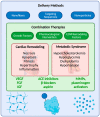Clinical Application of Novel Therapies for Coronary Angiogenesis: Overview, Challenges, and Prospects
- PMID: 33918396
- PMCID: PMC8038234
- DOI: 10.3390/ijms22073722
Clinical Application of Novel Therapies for Coronary Angiogenesis: Overview, Challenges, and Prospects
Abstract
Cardiovascular diseases continue to be the leading cause of death worldwide, with ischemic heart disease as the most significant contributor. Pharmacological and surgical interventions have improved clinical outcomes, but are unable to ameliorate advanced stages of end-heart failure. Successful preclinical studies of new therapeutic modalities aimed at revascularization have shown short lasting to no effects in the clinical practice. This lack of success may be attributed to current challenges in patient selection, endpoint measurements, comorbidities, and delivery systems. Although challenges remain, the field of therapeutic angiogenesis is evolving, as novel strategies and bioengineering approaches emerge to optimize delivery and efficacy. Here, we describe the structure, vascularization, and regulation of the vascular system with particular attention to the endothelium. We proceed to discuss preclinical and clinical findings and present challenges and future prospects in the field.
Keywords: angiogenesis; bioengineering; clinical trials; extracellular vesicles; gene therapy; stem cells.
Conflict of interest statement
The authors declare no conflict of interest.
Figures



References
-
- Harada K., Friedman M., Lopez J.J., Wang S.Y., Li J., Prasad P.V., Pearlman J.D., Edelman E.R., Sellke F.W., Simons M. Vascular endothelial growth factor administration in chronic myocardial ischemia. Am. J. Physiol. Circ. Physiol. 1996;270:H1791–H1802. doi: 10.1152/ajpheart.1996.270.5.H1791. - DOI - PubMed
Publication types
MeSH terms
Grants and funding
LinkOut - more resources
Full Text Sources
Other Literature Sources

